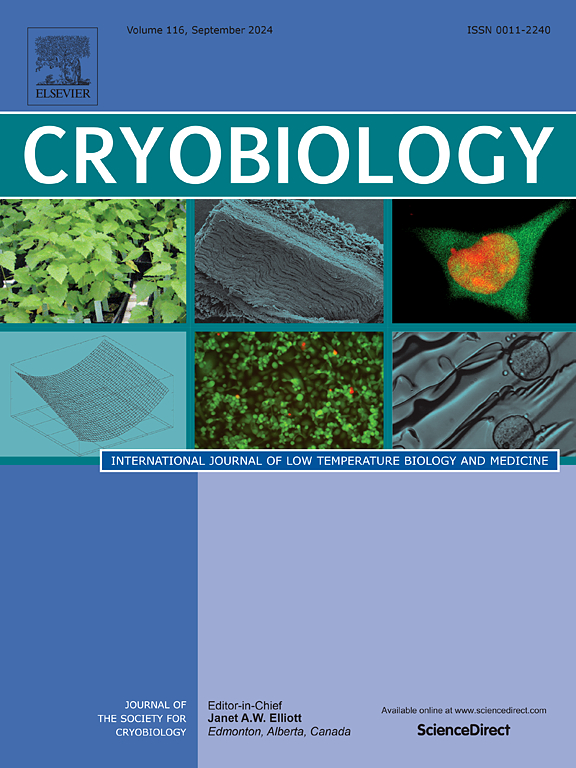Effect of vitrification on in vitro developmental competence of rat testicular tissue
IF 2.1
3区 生物学
Q2 BIOLOGY
引用次数: 0
Abstract
Cryopreservation of testicular tissue has been proposed as a potential technique for preserving fertility in pre-pubertal boys with various malignancies. The present study aimed to compare the effects of two vitrification techniques—solid surface vitrification (SSV) and needle-immersed vitrification (NIV)—on the integrity, development, cell viability, and apoptosis of rat testicular tissue. Testes from 4-week-old Wistar rats underwent a two-step vitrification process. Tissue pieces were allocated to either the SSV or NIV group. Equilibration involved a solution containing 7.5 % dimethyl sulfoxide (DMSO) and 7.5 % ethylene glycol (EG), followed by a vitrification solution with 0.07 mol/L sucrose, 15 % DMSO, and 15 % EG. The optimal protocol was determined after vitrification using either the NIV or SSV technique. Samples from the control and selected vitrification (SSV) groups were cultured for 3 weeks. Tissue integrity, cell viability, apoptosis, and gene expression were evaluated using hematoxylin and eosin staining, trypan blue staining, annexin V-PI staining, and real-time PCR. Morphological changes were more pronounced in the NIV group compared to the SSV group (P < 0.05). Although the percentage of viable cells did not significantly differ between the NIV and SSV groups, it was slightly higher in the SSV group. Thus, SSV was identified as the optimum vitrification method. Real-time PCR analysis revealed altered gene expression: spermatogonial-related genes (Lrp4, Egr3, Nanos, Gfra1, C-kit, and Sohlh1) were significantly decreased in the SSV group, while somatic-cells-related genes (Gdnf, Csf1, and Fgf2) were higher. Overall, SSV appears suitable for rat testis tissue vitrification, although it induces some molecular changes. Optimization of the culture medium is essential to support successful spermatogenesis.
玻璃化对大鼠睾丸组织体外发育能力的影响。
冷冻保存睾丸组织被认为是保存青春期前患有各种恶性肿瘤的男孩生育能力的一种潜在技术。本研究旨在比较固体表面玻璃化(SSV)和针浸玻璃化(NIV)两种玻璃化技术对大鼠睾丸组织的完整性、发育、细胞活力和凋亡的影响。4周龄Wistar大鼠睾丸进行两步玻璃化处理。组织片被分配到SSV组或NIV组。平衡包括含有7.5%二甲基亚砜(DMSO)和7.5%乙二醇(EG)的溶液,然后是含有0.07 mol/L蔗糖、15% DMSO和15% EG的玻璃化溶液。玻璃化后使用NIV或SSV技术确定最佳方案。对照组和选定的玻璃化(SSV)组的样品培养3周。采用苏木精和伊红染色、台盼蓝染色、膜联蛋白V-PI染色和实时PCR检测组织完整性、细胞活力、细胞凋亡和基因表达。与SSV组相比,NIV组的形态学改变更为明显(P < 0.05)。虽然NIV组和SSV组之间的活细胞百分比没有显著差异,但SSV组的活细胞百分比略高。因此,SSV被确定为最佳的玻璃化方法。实时荧光定量PCR分析显示基因表达改变:SSV组精原细胞相关基因(Lrp4、Egr3、Nanos、Gfra1、C-kit、Sohlh1)显著降低,而体细胞相关基因(Gdnf、Csf1、Fgf2)升高。总体而言,SSV似乎适合于大鼠睾丸组织玻璃化,尽管它会引起一些分子变化。培养基的优化是支持精子成功发生的关键。
本文章由计算机程序翻译,如有差异,请以英文原文为准。
求助全文
约1分钟内获得全文
求助全文
来源期刊

Cryobiology
生物-生理学
CiteScore
5.40
自引率
7.40%
发文量
71
审稿时长
56 days
期刊介绍:
Cryobiology: International Journal of Low Temperature Biology and Medicine publishes research articles on all aspects of low temperature biology and medicine.
Research Areas include:
• Cryoprotective additives and their pharmacological actions
• Cryosurgery
• Freeze-drying
• Freezing
• Frost hardiness in plants
• Hibernation
• Hypothermia
• Medical applications of reduced temperature
• Perfusion of organs
• All pertinent methodologies
Cryobiology is the official journal of the Society for Cryobiology.
 求助内容:
求助内容: 应助结果提醒方式:
应助结果提醒方式:


